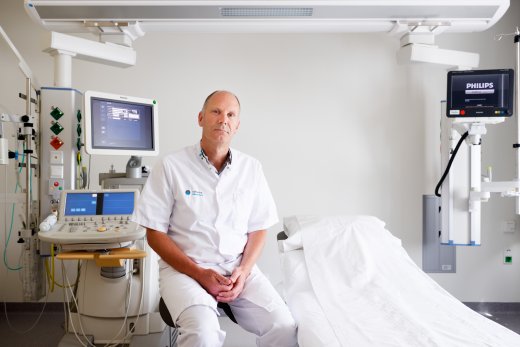07/08/2017
Easing the life of heart failure patients
My name is Hans Post. I have been a cardiologist for the past fifteen years at the Catharina Hospital in Eindhoven. While I was studying medicine I became fascinated with the functioning and possible dysfunctioning of the heart. The knowledge and skills required to become a cardiologist are very broad. The complexity of the heart and the detailed knowledge required of the mechanics and physiology of this organ, make the profession of a cadiologist very intellectually challenging. I used to focus on cardiovascular imaging, but during the past few years I have specialized in heart failure.
What is heart failure?
Heart failure is hard to define specifically. It is known as a problem where the pump function of the heart falls short in providing sufficient blood circulation, which comes with various consequences. Firstly, it results in the congestion of blood in the vascular system, which causes fluid to exit veins and accumulate in other areas of the body, such as the lungs for example, which leads to shortness of breath. The fluid can also accumulate in the lowest areas of the body, for instance in the feet and legs. Secondly, it can become dangerous when an insufficient amount of blood reaches vital organs. The liver, kidneys and even the brain can be affected. Furthermore, people can feel tired very quickly as low blood circulation causes a low amount of oxygen and nutrients to reach the muscles.
Heart failure can have many origins, but grossly has two patterns of appearance. The first is acute heart failure. This is the case when something happens that immediately affects the functioning of the heart, for example when a heart infarction strikes. The people suffering from this type of heart failure could have been in perfect health right up to the point of the infarction, after which they suddenly became heart failure patient. The second form of heart failure develops gradually. It can, for example, arise after having lived with high blood pressure for several years/decades .
Consequences
Heart failure is a chronic condition. Once someone has it, in many cases there is little hope for a full recovery. Most heart failure patients will have to learn to live with the disease for the rest of their lives.
Problems that often arise as a result of heart failure are, among others, fatigue and fluid accumulation. Some patients find having to swallow five or six pills per day the most trying aspect of their condition. Moreover, patients with heart failure have an increased chance of acquiring further (e.g. electrical) heart problems. Even small issues can cause a patient to have to go back to the hospital regularly and most heart failure patients are in and out of hospital many times for treatment and control.
Detecting heart failure
Detecting heart failure at an early stage is difficult. The problem is that heart failure causes symptoms which are similar to those of various other diseases. It is hard for General Practitioners to determine if a patient is suffering from heart failure or from something else on the basis of their complaints alone, which leads to relatively late detections for many patients. To confirm whether a patient has heart failure or not, often NT-proBNP is measured. This is a biomarker of which the concentration in blood can indicate heart failure. Measuring NT-proBNP is currently an important aspect of both the diagnosis and the monitoring of patients. NT-proBNP is the most useful indicator for heart failure today, as it has a very trustworthy negative predictive value, which entails that whenever the NT-proBNP level in the blood is normal, you can be almost 100% certain that the patient does not have heart failure.
Biosensors
A biosensor can provide a faster and easier way to measure NT-proBNP. This could play a significant role in monitoring the progression of the patient's condition. The advantages of monitoring patient data are currently thoroughly being investigated. It might prevent re-hospitalization or even help patients to live longer. Regular measurements with a biosensor could provide more accurate information to help monitor the patient's condition. My hope for the future is that on the basis of the data provided by a biosensor, patients will be able to adjust their medication to better fit their needs at a particular moment in time.
When it becomes possible to measure important indicators of heart failure at home, patients will not have to go to the hospital as much and will receive quicker results, which will drastically improve their quality of life. Biosensors are also very cost-effective as blood samples do not have to be sent to a laboratory anymore. Furthermore, with the use of these sensors heart failure can be detected earlier, or excluded from the possible diagnoses, even at the GP's office as NT-proBNP can be tested quickly and efficiently. Thus biosensors could reduce the time patients are uncertain about their disease, as the measurement is executed earlier in the diagnostic process. With the current method, measuring NT-proBNP levels takes some time, depending on the laboratory you send the results to. With a sensor like the ones that are being developed in the SensUs competition, a patient would see the results within five minutes.
SensUs
Even if the prototypes that the teams are developing do not work perfectly, the SensUs competition is very important. The effort and research that is put into the process of creating a biosensor will result in new knowledge. However, I do think that the teams will manage to produce a working biosensor. The devices that will be developed will be very useful in the healthcare domain. I look forward to seeing something beautiful created by SensUs.

Facebook
YouTube
LinkedIn
Instagram